Books to Papercuts
Seldom has a people’s cultural expression changed in so short a period of time as the revolution that overtook the Jews with the invention of moveable type and the printed book. Johannes Guttenberg’s invention in the 1450’s quickly swept south and the first Hebrew book, the Aruch, a lexicon for Talmudic study, was printed in Italy in 1470. The illuminated Hebrew manuscript was obsolete within a generation and was replaced by the printed book. The hand had been supplanted by the press.
Haggadahs, 16th to 20th century
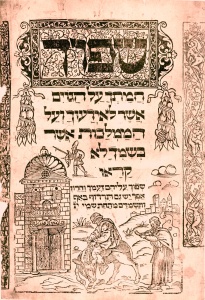
If synagogue floor mosaics characterized Jewish Art from the third to sixth centuries and the illuminated manuscript did the same for European Jewish Art between the thirteenth and fifteenth centuries, then the illustrated Haggadah is the fundamental Jewish Art expression from the Renaissance to the twentieth century. Five hundred years. The Haggadah is the most reprinted Jewish book in history (over three thousand editions have been collected) and is the most illustrated of Hebrew texts. The earliest printed Haggadah dates from approximately the first years of the sixteenth century and is quickly followed by twenty five separate editions in the next hundred years, many illustrated with woodcut prints. Four prototypical editions influenced almost all illustrations that followed up to the twentieth century: Prague, 1526; Mantua, 1560; Venice, 1609; and Amsterdam, 1695.
The sixty woodcut illustrations, many with ornate Renaissance borders, found in the Prague Haggadah became a template for most of the subsequent illustration depicting the preparation and celebration of Passover and biblical scenes from the narrative itself. The Mantua Haggadah shifts the stylistic emphasis to the Italian Renaissance, even going so far as to include an image by Michelangelo from the Sistine Chapel as the Wise Son. In what may be the most moving image in the Mantua Haggadah, “Pour out Your wrath…” the Messiah rides a donkey and is heralded with a shofar by Eliyahu ha Navi at the entrance to an Italian city. The yearning for the Messiah, a messiah now, to disperse those who oppress us is palpable, the integration of text and image, masterly.
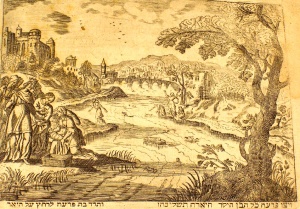
While the Venetian Haggadah also creates a whole lexicon of images (the Abraham narrative, the Exodus and even the encampment in the Wilderness) it is the Amsterdam Haggadah of 1695 that revolutionizes Haggadah images for the next two hundred years. It was the first to use copperplate engravings and presents images by the convert, Abraham ben Jacob who adapted the biblical engravings of the Christian artist Matthaeus Merian. This extensive suite of images Judaizes late Renaissance notions of form and content, allowing eighteenth century European visual culture to be imbibed in the homes of countless Jews at Passover. The proliferation of the printing press, a mechanized form of writing, had democratized all areas of Jewish learning and consequently, Jewish Art.
Return to the Manuscript
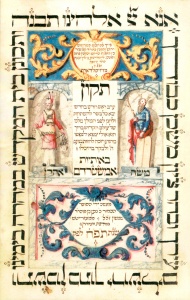
A rather curious thing happens to Jewish illustrated texts sometime in the eighteenth century. While the whole world produced printed books in hundreds if not thousands of copies, a small movement of Jews in middle Europe started to create (yet again) handwritten texts, frequently illuminated with watercolors and ink drawings. They were less narratively oriented and favored a decorative ornamentation of the text. Haggadahs were created copying the aforementioned illustrated printed editions. But more importantly there was a groundswell of individual works, many produced by sofers for their own use, that returned the care, love and handmade artistry to the Jewish book. The Tikun Erev Rosh Chodesh be’chadshoh (1728) from Rotterdam is a diminutive jewel, only 4” x 6 1/2” by the sofer and artist Nathan ben Samson of Mehzeritch. While the tiny book is laced with decorated letters delightfully ornate with multi-colored inks and floral designs, the glowing masterpiece is the title page graced with dedicatory cartouches framed by figures of Moses and Aaron in red and blue colored ink. The bold text surrounds color and image to produce a moving call to repentance, a cry for forgiveness carried up to Heaven in the form of Jewish Art.
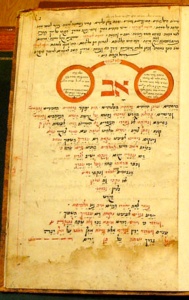
An earlier example of this manuscript renaissance is the handwritten and decorated Siddur of Shimshon ben Yochanan HaLevi, chazzan of Gelnhausen (Hesse, Germany) in 1673. The principle parts of the text are ornamented in much the same filigree style of manuscripts three hundred years earlier. The artist’s sense of drama, willfully creating title words in the center of the page and essentially redesigning with dramatically ornamented text design the flow of the prayers, sees the siddur as a fluid reservoir of religious emotion and artistic expression. The text of “Av haRachamim” before the Shabbos Musaf alternates between red and black text creating a funnel to concentrate the punishment of our oppressors. A brilliant red pair of eyeglasses surrounds the word “Av” to demand that God Himself closely examine and judge the actions of our enemies.
Personal Arts
Another aspect of Jewish Art that concentrates on individual use, as opposed to public use, and in a way humanizes the printed word is the twin folk arts of micrography and papercuts. Micrography (the use of sacred text, written very small, to create designs and images) originated in tenth century Egypt and Palestine, heavily influenced by Islamic culture. Hebrew micrography was the creation of the Masorah scribes of Tiberias and soon developed into a major element in illuminated manuscripts, embedding Masoric texts in architectural and abstract designs that surround sacred text. It was utilized in all kinds of illuminated texts; luxury Bibles, Haggadot, ketubbot, omer counters and amulets and easily made the transition into printed works. As it has developed into a medium to create full fledged images of increasing complexity (depicting many biblical narratives and Jewish themed images) it has remained a predominately Jewish art form.
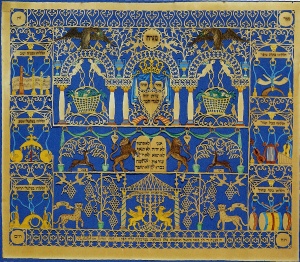
While micrography is a scribal art form, papercuts are also primarily a male folk art. Starting with young boys in heder who made the simple cut-out rosette designs to decorate windows for Shavous and to decorate the succah, the craft developed into much more sophisticated designs and themes. The earliest record of a Jewish papercut is in fourteenth century Spain. Actual examples, overwhelmingly from Eastern and Central Europe, are of course much later (the earliest from the eighteenth century) because of the inherent fragility of the medium.
The primary role of the papercut was to beautify the home interior, decorating walls with ornamented texts such as: mizrah, shivisi (also synagogue use), ushpizin for the succah, sefiras ha omer calendar, menorah and hamsa, amulets (especially for the newborn), bris, yartzait, ketubot, blessings and commemorations and even the Megillas Esther scroll. This art form essentially took important events and rituals and elevated them with skill and artistry as a hiddur mitzvah.
In the five hundred years since the inception of Hebrew printing the Jewish text has encountered and been enhanced by Jewish visual expression both in the mechanical printed book and the handmade creations of later manuscripts and papercuts. This integration, evidencing a continual stimulation of the visual imagination, perhaps laid some of the groundwork for Jewish participation in the larger European cultural environment encountered in the traumatic changes of the nineteenth century. That century would see the birth of modern Jewish painting, an art form that continues to the present day.
Editorial Note: This Jewish Art Primer is dependent upon my own research and many published studies and monographs on Jewish Art. At the end of the series a bibliography will be provided.